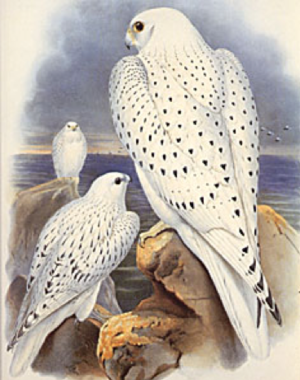Gyrfalcon
Gyrfalcon, Falco rusticolus
| Gyrfalcon | |
|---|---|

| |
| Gyrfalcon, Falco rusticolus. | |
| Scientific classification | |
| Kingdom: | Animalia
|
| Phylum: | Chordata
|
| Class: | Aves
|
| Order: | Falconiformes
|
| Family: | Falconidae
|
| Genus: | Falco
|
| Subgenus: | Hierofalco
|
| Species: | F. rusticolus
|
← Arctic_Life | ← More Animals | ← More Birds
Because of their large size – up to 63 cm, much bigger than a crow – and the stunning white plumage of some individuals, gyrfalcons have been prized by falconers for centuries.
General Information and Adaptations
Although gyrfalcons – pronounced "jer-falcons" – are classified as white, grey, or brown, their actual colour can range across a wide gradient from white to dark brown. The white morph is more common at higher latitudes, and may be an adaptation for arctic survival.
Behaviour and Distribution
Gyrfalcons are found in Canada, Alaska, Greenland, Iceland, northern Europe, and Asia. They are truly Arctic birds of prey, found only above the treeline and breeding all the way north to the tip of the Arctic islands. They are one of the only birds to winter in the Arctic, although they sometimes move southward, occasionally as far as the northern United States.
Gyrfalcons nest on cliff ledges protected by overhangs. They often overwinter in their breeding range, which enables them to claim the best nesting spots in the spring and ensures that they have more time in which to raise their young before cold weather returns in the fall. They lay 3–4 eggs, of which only the strongest hatchlings survive. Because gyrfalcons breed early, their young are learning to hunt just as other birds' offspring are hatching, providing the immature falcons with an easy source of prey. In a pair's first year of breeding, rudimentary nests are constructed out of twigs and vegetation, but they are built up into progressively larger structures over a period of several years. Gyrfalcons are monogamous, mating for several years or for life, and returning to the same territory year after year, although they may alternate between two or three different nesting sites within that territory.
Gyrfalcons prey mainly on ptarmigans, but lemmings and arctic hares are also important food sources. Instead of stooping like the peregrine falcon, the gyrfalcon generally hunts by flying low over the ground, chasing its prey. Although it does not make 300 km/h dives like the peregrine, this swift falcon can out-fly nearly all other birds!
Traditional Names and Uses
External resources
| Name | ID |
|---|---|
| NCBI Taxonomy | 120794 |
| WikiSpecies | Falco rusticolus |
| Wikipedia | Gyrfalcon |
| iNaturalist | Gyrfalcon |
| BOLD | 10292 |
